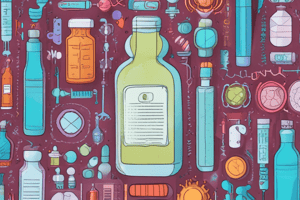Podcast
Questions and Answers
What mechanism do aminoglycosides use to kill bacteria?
What mechanism do aminoglycosides use to kill bacteria?
- Inhibition of cell wall synthesis
- Disruption of cell membrane integrity
- Inhibition of nucleic acid synthesis
- Inhibition of bacterial protein synthesis (correct)
Which of the following organisms are aminoglycosides standard treatment for in nosocomial infections?
Which of the following organisms are aminoglycosides standard treatment for in nosocomial infections?
- Clostridium difficile
- Staphylococcus aureus
- Streptococcus pneumoniae
- Escherichia coli (correct)
Which of the following is NOT considered an aminoglycoside?
Which of the following is NOT considered an aminoglycoside?
- Neomycin
- Amikacin
- Vancomycin (correct)
- Gentamicin
What type of infections are aminoglycosides primarily used to treat?
What type of infections are aminoglycosides primarily used to treat?
Aminoglycosides are particularly effective against which type of Gram bacteria?
Aminoglycosides are particularly effective against which type of Gram bacteria?
Which of the following aminoglycosides is often used in treating severe infections caused by Pseudomonas species?
Which of the following aminoglycosides is often used in treating severe infections caused by Pseudomonas species?
Flashcards
Antimicrobial Agents
Antimicrobial Agents
Chemicals that kill or inhibit the growth of disease-causing microorganisms in the human body.
Antibacterial Agents
Antibacterial Agents
Specific type of antimicrobial agent designed to target and kill bacteria.
Aminoglycosides
Aminoglycosides
A class of antibiotics that work by interfering with bacterial protein production.
What are Aminoglycosides used for?
What are Aminoglycosides used for?
Signup and view all the flashcards
What are Aminoglycosides used for (Nosocomial Infections)?
What are Aminoglycosides used for (Nosocomial Infections)?
Signup and view all the flashcards
Which drugs belong to the Aminoglycoside class?
Which drugs belong to the Aminoglycoside class?
Signup and view all the flashcards
Study Notes
Antimicrobial Agents
- Antimicrobial agents are chemicals that eliminate pathogenic microorganisms in humans.
- These agents can be chemical (e.g., sulfonamides) or derived from other microorganisms (e.g., penicillins).
Antibacterial Agents
- Antibacterial agents are antimicrobials targeting bacteria.
- Aminoglycosides inhibit bacterial protein synthesis, killing bacteria.
- Used against Gram-negative microorganisms causing urinary tract infections, meningitis, wound infections, and severe sepsis.
- Standard treatment for hospital-acquired (nosocomial) Gram-negative infections from specific bacteria such as Acinetobacter, Citrobacter, Enterobacter, Escherichia coli, Kleibsiella, Providencia, Pseudomonas, Salmonella, and Shigella.
- Examples of aminoglycoside agents include amikacin, gentamicin, kanamycin, neomycin, netilmicin, streptomycin, and tobramycin.
Studying That Suits You
Use AI to generate personalized quizzes and flashcards to suit your learning preferences.




